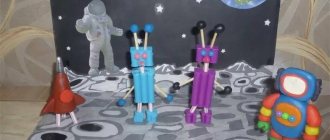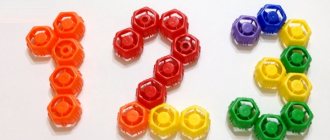Who's the odd one out?
It was necessary to find an extra card in a row.
A file with cards is possible.
Dasha could not find all the extra cards on her own; she needed a hint. For example, for these cards:
there was this hint: “Rockets are about to fly into space. Everyone was flying high, high! Up to the stars! But one did everything wrong! What kind of rocket was it?
In principle, such hints can be given to any row of cards if the child finds it difficult to choose the extra one. It’s just that it can be difficult for children to complete not the task itself, but to understand the logic of the question - how is it “extra”. Simple hints can help with this, and over time the child will get used to the concept of “extra” and learn to look for an extra card without hints.
For the fact that the child guessed every extra card, he is entitled to a PRIZE - the guessed card is given to him as a prize forever (children love small bright pictures, and usually the prospect of winning such a prize is very motivating to complete the task).
Charging an astronaut
Flexible breaks between tasks are very important! Some children will not be able to conduct a lesson at all without them (we are just part of this group of “some” fidgets).
I told Dasha that we really need to fly into space, but only very strong people are accepted there and the astronauts train a lot before the flight. Therefore, we need to do good exercises.
The charging tasks were as follows (the pictures are not the most “designer” - I apologize, this is not my profile):
Exercise 1. Running around the room - for warming up.
Exercise 2. Walking on your toes, on your heels, walking along a massage path (any other massage surface - cereals, pebbles, pencils, etc.).
Fitball exercises.
(If you slightly change the exercises, you can use a simple ball of medium diameter. Attention! When performing all the exercises, hold the child tightly. You can secure the baby well if you take his two legs in your hands and press them tightly to the ball, and hold the ball itself with your feet. )
Exercise 3. We train the vestibular apparatus (everything like real astronauts). We sit the child on the ball, holding his legs tightly, and begin to bounce up and down on the ball (it turns out that the baby seems to be jumping on the ball). Then we place the child on his back on the ball and rotate the ball clockwise and counterclockwise.
We strengthen the abs and lower back muscles.
Exercise 4 . The child sits on the ball, the mother secures it well, taking both legs and pressing them to the ball (so as not to drop it! This is very important!). We begin to rock the child back and forth. We try to make the maximum possible amplitude.
Exercise 5. Swing the child on the ball left and right:
Exercise 6. Still fixing the child well, we rotate him and the ball in a plane parallel to the floor, clockwise and counterclockwise (as the green arrow in the photo suggests):
When performing these three exercises, the child will involuntarily deviate back and forth, while the abdominal and back muscles are well worked out.
Strengthening your arms and back.
Exercise 7. We ask the child to pick up toys from the floor (the toys are positioned so that he has to reach them in his arms):
Exercise 8. We ask the child to raise his hands up - we fly up like a rocket. If the child does not comply with the request, you can ask him to take the toy that we hold above his head.
Exercise 9. Walking on your hands around the room is an excellent exercise for your arms, back, and abs:
Exercise 10. Stepping over obstacles (strengthening the legs) - lay out tall objects on the floor (stuffed toys, pillows, stacks of books, anything taller than 30 cm). We ask the child to step over them (while raising his legs high).









